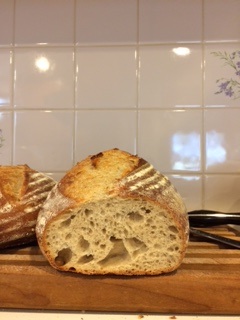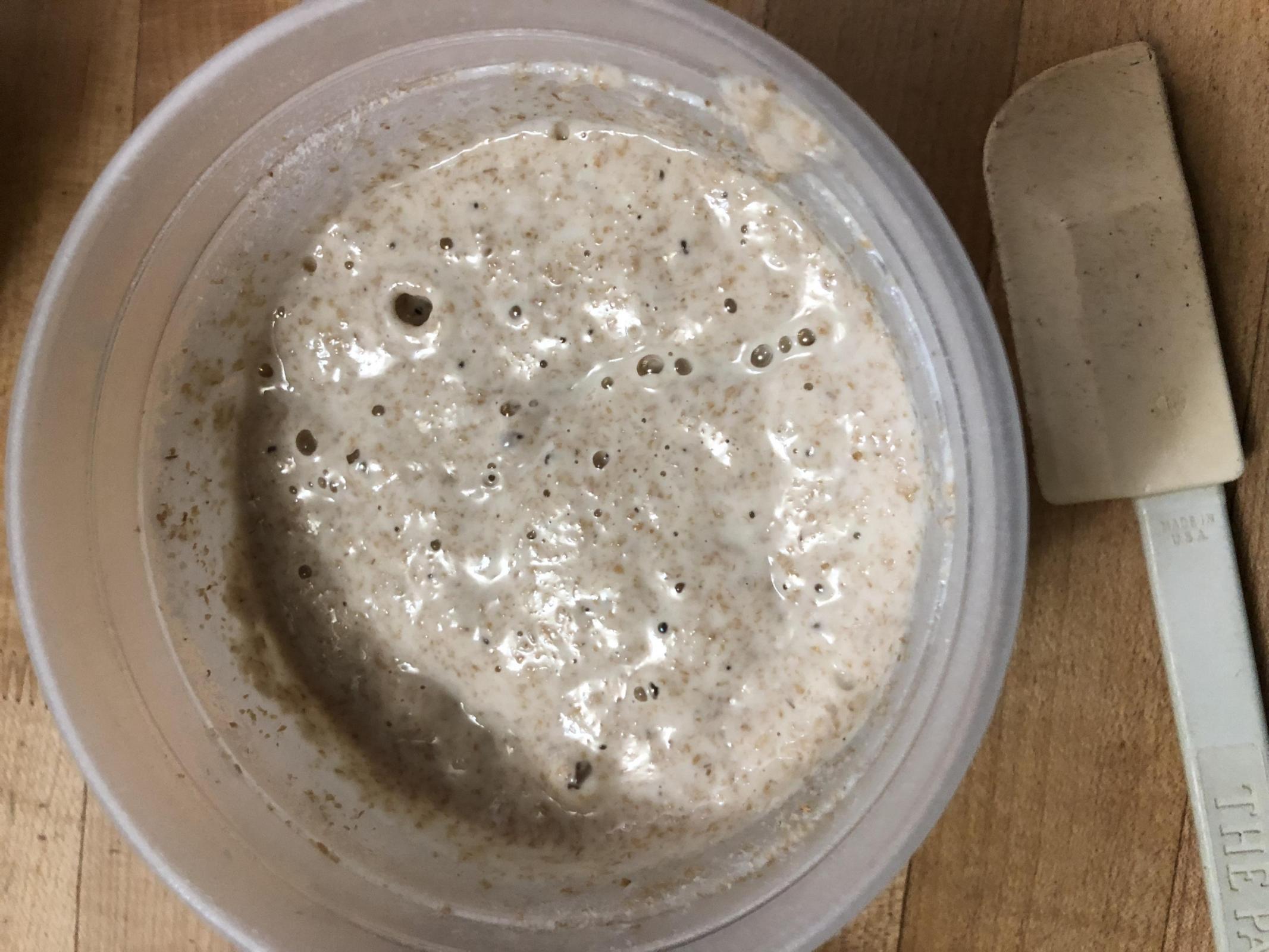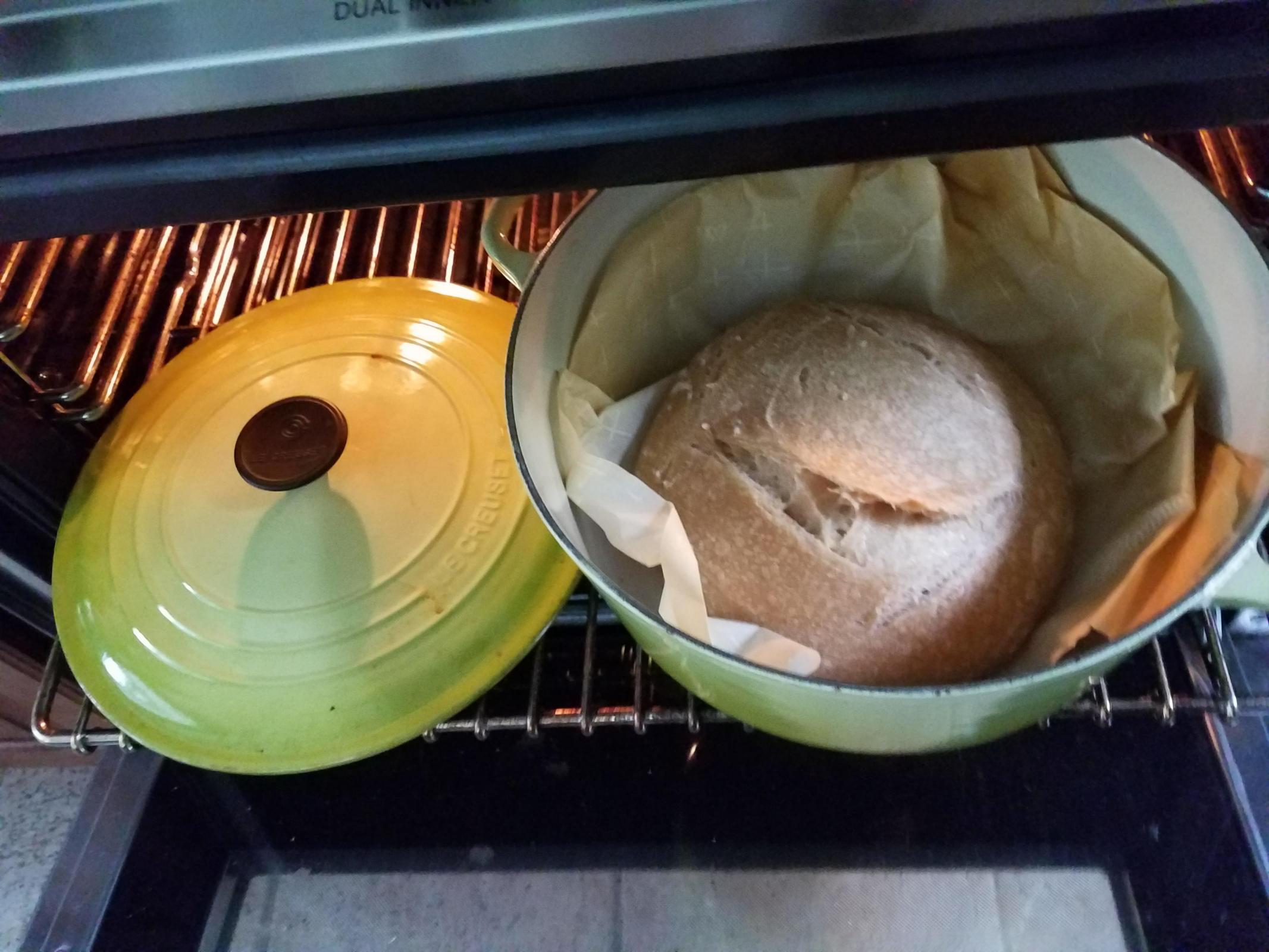Sorry for these elementary questions but confusion reigns yet again! I use my WW starter to bake weekly and store it in the fridge between bakes. Now, instead of refreshing the seed starter once to make a levain for baking, I would like to try two feedings in an attempt to make the starter super-active. ( with one feeding my starter is bubbly and seems very mature, but it does not pass the float test). My question is as follows: with the second feed, do I need to discard some of the first feeding before adding more flour and water or do I simply add them to the first feeding without discarding any?) Many thanks in anticipation of generously shared expertise! Perhaps one day all my changes will be made automatically and with confidence! Valerie
It is completely dependent upon how much starter or Levain you want. The reason it is recommended to remove some of the old starter is because if you don’t it will get huge in a short amount of time.
Dan
Hey Valerie, you can edit the duplicate post (both subject and body to say something like “Disregard, duplicate post”. This will avoid confusion.
Many thanks, Dan. You have probably noticed that my computer skills are as elementary as my bread-making skills! Valerie
Leslie
starter attempt day 30.
I'm feeding it every day.
pour out all but abt 125 grams.
adding basically 125 grams filtered water and 125 grams of whole wheat bread flour/whole wheat flour.
after about 6 hours it has abt 25% growth.
after about 12 hours it's nearly doubled in size.
after 24 hours, it's back to just abt 25% growth.
BUT IT NEVER FLOATS.
What, tell me PLEASE, am i doing wrong?
Thank you,
Mark
down before you do the float test? Or are you simply scooping some up with a wet spoon or hand, and gently placing it in water? I am wondering if you are knocking all the air out before your float test.
I just scoop a little out with a spoon and try to lay it gently in a cup of water.
drops straight to the bottom every time, even though the starter looks bubbly/frothy.
I even tried the float test when the starter was at it's peak... still sinks.
I'm just out of ideas.
All informed friends and family are looking at me like i'm nuts at this point...
are you feeding it? Equal proportions? By weight? More water than flour? Is your starter really liquid?
esp. if you have (looks like you do) a high hydration (100%) starter. Here's a helpful link for you: http://www.thefreshloaf.com/node/48981/float-test
If your starter is behaving as it should do not worry, Just bake!!! You'll get great bread. I never use that test, ever.
hester
you don’t need your starter to float for it to work. And that’s exactly where I was going with my questions above. I wondered if your starter is too liquid to float. If that’s the case, you might want to give it more flour than water and then try the float test. It is kind of cool to see it float.
Thank you Very Much Hester and Danni.
Maybe I'll take a risk and try to make some bread!
I am so psyched to do this.
Danni, It's not very watery. It seems like the consistency that all the videos seem to be going for... maybe slightly thicker. But I haven't tried dipping a spoon in water before trying the float test. perhaps I'm popping all the bubbles through friction with the spoon?
I WANT THE FLOAT!!!
a 100% starter ain't gonna float, as least not reliably or well. Stiffen it up to 60% and you'll see it float.
hester
Hester, so, (just want to get the ratios you suggest correctlyl) for example, i should do a feed of 125g water and 208 g flour?
The reason to do it, is to prove to yourself you can. I tried a float test in my early baking days. Then came to understand that it is not necessary and in fact useless w the 100% hydration starter. I'm posting a pic one of my last bakes to show you, that a float test is not necessary. Never did a float test for this one.

Do it for yourself. then if you are keeping a 100% hydration starter, just forget about it and go bake!!
Hester
Hester! that looks like one fantastic loaf of sourdough. You and Danni have really got me inspired. Thank you both so much for getting me back on track.
don't think I've ever done a float test
Hester and Danni, how were you able to determine that the starter was ready to use if not via successful float test?
if not more for me. It also has bubbles bursting at the surface. I tend to keep a thicker levain so those are my indicators. With a thinner Levain, the surface can look very similar to boiling water and it may not double but you can tell there is a lot of activity.
Here is a picture of a thinner levain.
it's basically doubled since i fed it yesterday at 3:30 pm.
seems like you're telling me it's ready...
Very Exciting
But you're looking at 6-8 hours for a starter to peak. What was this feed and how long did it take to peak?
It's ready. My 100% starter just has bubbles all over and rises. Forget the float test. Bake w that beautiful stuff.
hester
alrighty. I'm going to feed it this afternoon and tomorrow... LIFTOFF
Thanks again
Danni and Hester.
Well, I tried to get it going, but all i wound up with was a lump of dense, whole wheat colored cement. my concoction was
400g whole wheat bread flour
400g whole wheat flour
460g filtered, luke warm water
10g salt
320g starter
which i got from
https://www.youtube.com/watch?v=_V1jqzwaYhg
I started in in a mixer, which quickly bogged down.
went to working the dough by hand.
I "thought" i'd done enough when the "window" test sort of worked.
Then put it up for 1st proof.
in the video, it was supposed to have basically doubled and gotten much more pliable.
I could only use my resulting proofed dough (which did NOT double... didnt change at all) as mortar to build the foundation for the house whose roof once built, i'd like to jump off of due to the frustration.
So,
dont know why it didnt work, but it suuuukkkkkeeed. so i tossed it out.
Now i'm trying to fire the starter up again.
going to try 100% unbleached (non whole wheat) bread flour. maybe?
IS THIS ALL BECAUSE THE STARTER JUST ISN'T ANY GOOD?
IS WHOLE WHEAT BREAD/FLOUR the wrong stuff?
WHAT
DID
I
DO
WRONG???
THOUGHTS?!
Thanks,
your sad, sad little faux bread baker,
Mark
Whole wheat bread flour and whole wheat flour?
Not surprised it's dense. Where's the rest of the water? Surely that's not all of it!
This is what I found on your link:
400g of Strong White flour
290g of lukewarm water
10g of extra water + 7g of salt
150g sourdough starter
Extra boiling water included for filling up the channel of The Spring Oven
Just sayin'
So, you doubled the flour but not the water, which might have something to do with your problem. Recipe also calls for strong white flour and not whole wheat. I will leave it to the more competent participants here to expound on why this could have been a recipe for trouble.
Better bread next time!
Carole
This is so weird. here is what i get from the website:
White Sourdough
(Makes 2 loaves. Halve the amounts for a single loaf)
so i'm all confused... although it does look like a big ration of flour to water.
which can be fine using flour from certain countries but with Canadian or American flour, it would be really hard to mix up. Feel free to add or subtract water if the recipe doesn’t feel right. I know that there is no way I would be able to mix that with my Canadian flour.
I just clicked on your link again and get the same recipe for 3 minute basic sourdough loaf. Someone's confused. And it looks like you no longer will be!
Recipe called for 800g flour, 460g water, 10g salt, 320g starter.
how much water do you suggest for 800g flour?
also, what are your suggestions about type of flour? ww bread flour? just plain whole wheat flour? unbleached white bread flour?
If you’re working with all whole wheat, the ~64% hydration that this comes out to is too low. Whole wheat absorbs a lot more water than does white flour, and ~64% is a reasonable number for a white dough. I haven’t played around much with whole wheat, but I’d expect something like 800g flour, 560g water, 10g salt, 320g starter would work better. That works out to more like 75%, which should be a much better dough to work with. Autolysing (mixing just the flour and water and letting it sit) for an hour or so before you add the starter and salt should also help improve the pliability of the dough and save you from having to knead so much. For whole wheat, it helps the bran absorb water and soften, which lets you develop gluten without tearing it as much.
If you want to stick to the recipie you’ve already got, try 10-15% whole wheat with the rest being white. It really improves the flavor a lot over an entirely white bread.
and start with plain Unbleached all purpose flour. You can play with adding Wholewheat after you got a handle on this recipe.
And at 64.5% hydration I suggest either all strong bread flour or 90% strong bread flour + 10% whole wheat flour.
The site you got the recipe from is British. British flour absorbs way less water than flour from across the pond. You don’t say where you are from but if you are from Canada or the US, you need more water as suggested by other members. Lechem is British so that recipe would work for him.
DAMN this stuff is technical. makes me pine away for chocolate chip cookies! I am in NY so I guess I've got the more absorbent flour?
Seriously, thank you all so much for your input. i'm going to
1.change to mostly white bread flour (90/10 white v wheat).
2. increase the water (560g as suggested by pogrmman)
3. sift the flour before mixing
4. let the autolyse sit for a while before adding starter.
5. cross my fingers and hope for the best.
Cheers!
Mark,
So sorry about your frustrations. I shared them. I have two really great pieces of advice for you (that others shared with me):
1. Take a small-medium tupperware like tub and mix half (by weight) white, unbleached, all purpose flour and half (by weight) unbleached whole RYE flour) - use that mixture to feed your starter. So, 1/2 existing starter, 1/4 water and 1/4 the flour mixture (all by weight) would be your feedings. I typically start with 20 g starter, 10 g water and 10 g of the flour mix and go from there. I always make sure the additional flour and water are equal to or greater (by weight) than by beginning portion of starter. The Rye flour makes the starter SO MUCH BETTER to work with, and it doesn't influence the taste that I can tell (my wife HATES rye bread and can't tell).
2. Try a 1-2-3 recipe: 1 part starter, 2 parts water and 3 parts flour (by weight) - keep your loaves to around 600 g to start to keep it simple, then you can experiment from there. So, 100 g of your starter, 200 g of water, 300 g flour (try all bread flour or half bread flour and half all purpose white), which gives you a roughly 70% hydration dough which is nice to work with.
The nice thing about the 1-2-3 (for me) was that I could adjust very easily and just keep the ratio, but if I wanted to experiment with higher hydration or different flours, it was easy to compare (I made a spreadsheet to plug in numbers to tell me the hydration level and I keep a notebook of the changes I make in each loaf so I can repeat when I hit a sweet spot)
Hang in there, it's SO worth it!!
As soon as my starter gets back to high activity level...I'm going to dive back in!
THANK YOU Danni, Lechem, Pogrmman and everyone else. I finally got liftoff!

btw, here is the link for the recipe i used, which worked EXACTLY as the instructions and pictures indicated.
https://www.theperfectloaf.com/beginners-sourdough-bread/
Can't beat that feeling when it works. Enjoy! And looking forward to the crumb shot with taste report.
congrats on your SD loaf - it looks great!
don't cut it till it's cool, of course, but when you do, i can't wait to see a pic of the crumb :)